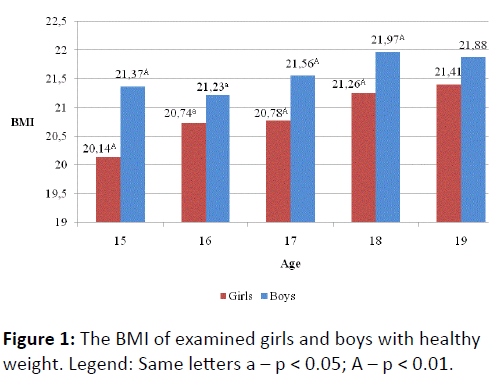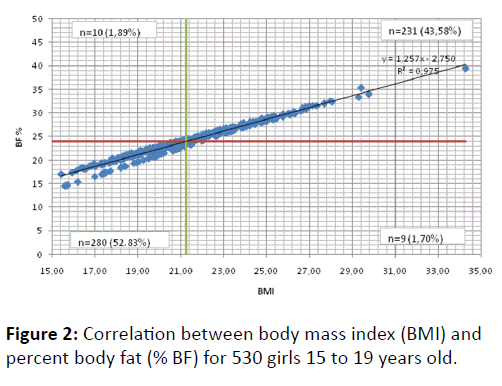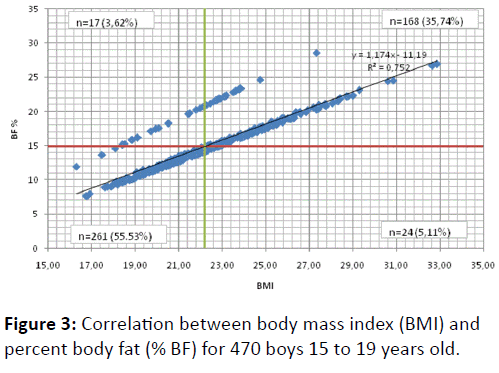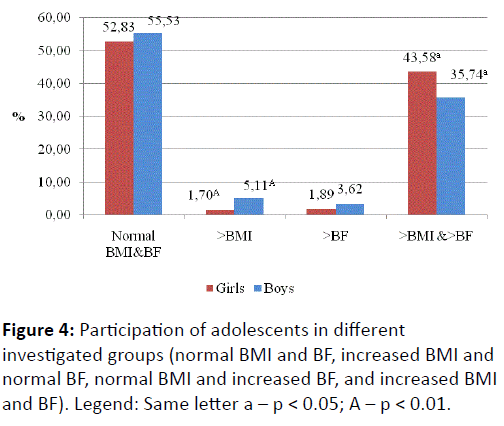Janjic Jelena1*, Baltic ZM1, Glisic Milica1, Ivanovic Jelena1, Boskovic Marija1, Popovic Milka2 and Lovrenovic Mirjana3
1Department of Food Hygiene and Technology, Faculty of Veterinary Medicine, University of Belgrade, Serbia
2Department of Hygiene and Human Ecology, Faculty of Medicine, University of Novi Sad, Serbia
3Pan-European University APEIRON Banja Luka, Serbian Republic
- *Corresponding Author:
- Janjic Jelena
Department of Food Hygiene and Technology
Faculty of Veterinary Medicine
University of Belgrade, Serbia
Tel: 060-063-0-366
E-mail: jeckonbg@gmail.com
Received Date: April 04, 2016; Accepted Date: May 10, 2016; Published Date: May 16, 2016
Citation: Jelena J, Baltic ZM, Milica Z, et al. (2016) Relationship between Body Mass Index and Body Fat Percentage among Adolescents from Serbian Republic. J child Obes 1:10. doi: 10.21767/2572-5394.100010
Copyright: © 2016 Jelena J, et al. This is an open access article distributed under the terms of the Creative Commons Attribution License, which permits unrestricted use, distribution, and reproduction in any medium, provided the original author and source are credited.
Keywords
Body mass index; Body fat; Adolescents; Dietary habits
Introduction
Adolescence is an important stage of life when lifestyle behaviours including dietary habits are formed and become established. The lifestyle behaviour patterns that are established during early years can have important implications on health and well-being [1]. Calculating Body Mass Index (BMI) it can be determined which person is overweight or obese. BMI range varies with the age and sex of the adolescents (Table 1). Center for disease control and prevention [2,3] defined overweight adolescents as a BMI at or above the 85th percentile and below the 95th percentile and obesity adolescents as a BMI greater than the 95th percentile. The reference data that these percentiles are based on is from 1963 to 1994 and thus has not been affected by the recent increases in rates of obesity [4]. The frequency of obesity among adolescents is higher than it used to be, all over the world. In the United States after 1960s, 15% of school children were classified as overweight [5].
| Age |
BMI - Percentile Range |
| Underweight <5% |
Healthy weight 5% - 85% |
Overweight 85% - 95% |
Obese >95% |
| Girls/Boys |
| 15 |
<16.21/16.57 |
17.23-24.28/ 17.79-23.82 |
24.28-27.89/ 23.82-27.86 |
>27.89/27.86 |
| 16 |
<16.55/17.00 |
17.59-24.68/ 18.35-24.63 |
24.68-28.45/ 24.63-28.69 |
>28.45/28.69 |
| 17 |
<16.76/17.29 |
17.84-25.07/ 18.72-25.44 |
25.07-28.95/ 25.44-29.50 |
>28.95/29.50 |
| 18 |
<16.87/17.50 |
18.01-25.34/ 18.95-26.08 |
25.34-29.23/ 26.08-29.89 |
>29.23/29.89 |
| 19 |
<17.00/17.77 |
18.20-25.58/ 19.25-26.53 |
25.58-29.37/ 26.53-29.98 |
>29.37/29.98 |
| Source: National Health and Nutrition Examination Survey 2011 - 2012 Data Documentation, Codebook, and Frequencies |
Table 1: Reference values of BMI (kg/m2) according to recommendations of NHANES (CDC, 2011).
The only body measurement that directly calculates the relative composition of the body and present a measure of fitness level, regardless of height and weight, is body fat percentage (% BF). Widespread application of Body Mass Index (BMI) affords a measure which enables comparison with the overweight of individuals of different heights and weights.
While BMI greatly increases with obesity, due to differences in body composition, other indicators of body fat provides more precise results; for example, individuals with more muscle mass or with larger bones will have higher BMI. BMI presents a useful indicator of the overall fitness for large groups of people, but a bad tool to determine the health of an individual.
Important indicator of health of adolescents is nutritional status. The protein and salt content play a great role in the nutrition of adolescents. However, many studies examinated the influence of fast food consumption to obesity of adolescent [6]. Childhood obesity has epidemic proportions in the 21st century, especially in developed countries. USA population had the highest prevalence of obesity while Italians, French and Serbian population. For example, obesity in Canadian boys have increased from 11% in the 1980s to over 30% in the 1990s. During this same time period, obesity in Brazilian children increased from 4 to 14% [7]. On the basis of 1996 and 2000 studies the prevalence of underweight and obesity in Serbia do not change significantly, and for ten years now there is a trend of increasing prevalence of stunting [8]. According to the 2006 health survey of the Serbian population, two thirds of children and adolescents were in the normal nutritional status (67.7%). Almost one fifth of the young (18%) were overweight or obese, which is an increase in comparison with 2000. Also, fall of the number of underweight children (6.2%) in comparison with 2000 (8.4%) was noted. The increase in the number of overweight and obese children resulted from poor dietary habits and insufficient exercise, presenting an important public health problem [9]. For explanation for very low prevalence of obesity which found among Serbs may be the fact that Serbian population has suffered enormously during last decade due to war. In the Europe, Greeks are the most obese and overweight while Serbs the leanest. It can be explain with nutrigenomics and epigenetics factors.
Many factors contribute to the increased of childhood obesity. The diet (e.g. fast food) and decreasing physical activity are believed to be the two most important causes for increase in the incidence of childhood obesity [10]. Because childhood obesity often persists into adulthood and is associated with numerous chronic diseases (hypertension, diabetes, hyperlipidemia, and fatty liver), [11]. Treatments used in children are primarily lifestyle interventions and behavioral techniques have a little success [12]. The most common consequences of obesity are metabolic syndrome, cardiovascular diseases, etc. which can cause death in many countries (adult and children) [13,14]. World Health Organization [14] presented that, in 2014, 600 million adults and 42 million children under the age of five were overweight.
Population of different localities has different habits. Serbian Republic is a poor country. Years of life (during 1990s) under severe stress have brought depression and hopelessness, followed by general negligence towards health and increased risk behavior [15]. After that period, the health status of the population of Serbia was harmfully influenced by numerous factors (the long-lasting economic crisis, the consequences of war in the surrounding countries and in Serbia as well, economic and diplomatic sanctions) [16-18]. In addition to body weight, the amount of body fat and muscle mass is significantly increased during adolescence. In adolescence eating disorders are common or at least improper relationship with food.
This article discusses adolescents aged 15 to 19 years who were classified as overweight or obese according to their Body Mass Index (BMI), based on measured body height and body weight and it was determined the relationship between BMI and % BF among adolescents of Serbian Republic.
Methods
Sample
During 2014, 1000 healthy adolescents (ages, 15-19 years) were examined partly from different areas in Serbian Republic (Banja Luka city and municipalities Gradiska, Srbac, Teslic, Celinac). The Ministry of Education and Ministry of Health of the Republic of Serbian approved the study protocol (from each volunteer’s parent or guardian, or participants over 18 years sign consent by themselves). A questionnaire was used to determine demographic data (gender, age, number of people in household).
Anthropometry
Measurement of the body mass was performed using a decimal scale in kilograms, after the removal of shoes and excess clothing. The measurement of weight was to the nearest 100 g. Height was measured to the nearest 0.1 cm, without shoes, using a mounted metal centimeter ruler. The body mass index (BMI) was calculated as ratio between weight in kilograms and height in meters squared (weight in kg/height m2). BMI percentiles were calculated, and the Centers for Disease Control and Prevention (CDC) standards were used to classify children and adolescents as underweight (BMI < 5th percentile), healthy weight (< 85th percentile), at risk of overweight (≥ 85th and < 95th percentile), or overweight (≥ 95th percentile) (Table 1).
Deurenberg et al. [19] derived formulae for estimate the body fat (% BF) from the BMI. For these calculations, age and sex must be included for determination the relationship between densitometrically determined body fat percentage (% BF) and BMI. Internal and external cross-validation of the prediction formulas showed that they gave valid estimates of body fat, between sex at all ages. However, the prediction formulas slightly overestimated the BF %. The prediction error is comparable to the prediction error obtained with other methods of estimating BF %, such as skinfold thickness measurements and bioelectrical impedance. The most commonly used formula for relationship between BMI and BF % in children is present by Deurenberg et al. [19].
Child body fat % = (1.51 × BMI) − (0.70 × Age) − (3.6 × sex) + 1.4
Adult body fat % = (1.20 × BMI) + (0.23 × Age) − (10.8 × sex) − 5.4
where sex is 1 for males, and 0 for females.
Statistical analyses
Statistical analysis of the results was conducted using software GrapfPad Prism 5.00 (Version 5.00 for Windows, Graph Pad Software, San Diego California USA, www.graphpad.com). All parameters were represented by descriptive statistical parameters (mean, standard deviation). One-factor analysis of variance-ANOVA and post Tukey test were used for testing differences among BMI of examined girls and boys of the same age with healthy weight. For examination the ratio of BMI to BF we used Pearson correlation coefficients and Chi-square test was used to compare frequencies among girls and boys in different categories of adolescent, divided into four groups (normal BMI and BF, increased BMI and normal BF, normal BMI and increased BF, and increased BMI and BF).
Results and Discussion
Nutrition has exerted a role in human evolution [20,21]. Tables 2 and 3 showed characteristics of the adolescents, by sex and age. Laurson et al. [22] claimed that the BMI thresholds were more strongly associated with metabolic syndrome in boys than in girls. In our results girls become obese earlier than boys with 15 years (2.04%), while boys get fat with 16 years (3.08%). Girls are quick to develop, complete with the growth and metabolism of them is different from boys. At the age of 19 all the boys have normal weight, while in girls has above and below healthy weight. Girls in the late adolescent years, in addition to obesity, have a problem with underweight [23]. Pokrajac-Bulian and Ambrosi-Randic in their study concluded that the girls in Croatia with high scores on the internalization and awareness scales were the most dissatisfied with their bodies [24].
| Age |
BMI - Percentile Range |
| Underweight <5% |
Healthy weight 5% - 85% |
Overweight 85% - 95% |
Obese >95% |
| n |
% |
n |
% |
n |
% |
n |
% |
| 15 (n=49) |
3 |
6.12 |
44 |
89.8 |
1 |
2.04 |
1 |
2.04 |
| 16 (n=129) |
2 |
1.55 |
115 |
89.15 |
9 |
6.98 |
3 |
2.32 |
| 17 (n=106) |
3 |
2.83 |
95 |
89.62 |
8 |
7.55 |
0 |
0 |
| 18 (n=180) |
3 |
1.67 |
165 |
91.67 |
12 |
6.67 |
0 |
0 |
| 19 (n=66) |
1 |
1.51 |
60 |
90.9 |
5 |
7.57 |
0 |
0 |
Table 2: Body Mass Index classification according to age among girls (n = 530).
| Age |
BMI - Percentile Range |
Underweight
< 5% |
Healthy weight
5% - 85% |
Overweight
85% - 95% |
Obese
> 95% |
| n |
% |
n |
% |
n |
% |
n |
% |
| 15 (n = 37) |
1 |
2.7 |
32 |
86.49 |
4 |
10.81 |
0 |
0 |
| 16 (n = 130) |
3 |
2.31 |
104 |
80 |
19 |
14.61 |
4 |
3.08 |
| 17 (n = 154) |
1 |
0.65 |
130 |
84.42 |
22 |
14.29 |
1 |
0.65 |
| 18 (n = 109) |
0 |
0 |
101 |
92.66 |
8 |
7.34 |
0 |
0 |
| 19 (n = 40) |
0 |
0 |
40 |
100 |
0 |
0 |
0 |
0 |
Table 3: Body Mass Index classification according to age among boys (n = 470).
Poor nutrition and lack of appropriate physical activity are major cause of obesity. Serbian Republic and neighbouring countries are areas in which people always used to have a habit to eat a lot of food because they were dealing with agricultural and hard physical works [23].
The obtained results showed that the majority of examined adolescents are in the group of healthy weight. But, also we can concluded that there is significantly more (p < 0.01; p < 0.05) boys (ages, 15-18) with a healthy weight than girls (Figure 1). These results are in accordance with Freedman et al. [5]. In the Republic of Serbian children are genetically higher and have a balanced body composition. Serbs make up three-quarters of a dinar type of man, which is characterized by tall and slender physique, strong bones and developed muscles [25].
Figure 1: The BMI of examined girls and boys with healthy weight. Legend: Same letters a – p < 0.05; A – p < 0.01.
Figures 2 and 3 show that correlation BMI and % BF was very strong, positive, among examined girls (r = 0.975) and boys (r = 0.752). Data in the upper left and lower right quadrants present limitations of BMI. In the upper left quadrant % BF indicates excess adiposity, while BMI does not, and BMI indicates excess adiposity in lower right quadrant while % BF does not.
Figure 2: Correlation between body mass index (BMI) and percent body fat (% BF) for 530 girls 15 to 19 years old.
Figure 3: Correlation between body mass index (BMI) and percent body fat (% BF) for 470 boys 15 to 19 years old.
Other studies have reported that the accuracy of BMI as an indicator of obesity among children increases with the level of BMI (relative to sex and age) or % BF [5,26]. The distribution between muscle mass and fat mass are inexact for BMI or % BF. BMI generally overestimates adiposity on those with more lean body mass (e.g., athletes) and underestimates excess adiposity on those with less lean body mass. BMI is particularly inaccurate for people who are very fit, even though their body fat percentages frequently fall in the 10–15% category, which is below that of a more physical inactivity person of average build who has a normal BMI number. Body composition for fit person is better calculated using measures of body fat [27].
More than a half of respondents had a normal BMI and % BF (Figure 4). In a group with normal % BF and increased BMI there were significantly more (p < 0.01) boys than girls, and the opposite situation were in a group with increased BMI and %BF, where it was significantly more (p < 0.05) girls than boys. Obtained results emphasize the limitations of BMI as a marker of adiposity among non-overweight adolescents. Because of the variability in the levels of fat mass, weight–height index needs to be carefully discussed. The high levels of BMI-for-age are associated with substantial increases in fat mass, so the index is most useful as a measure of obesity.
Figure 4: Participation of adolescents in different investigated groups (normal BMI and BF, increased BMI and normal BF, normal BMI and increased BF, and increased BMI and BF). Legend: Same letter a – p < 0.05; A – p < 0.01.
Conclusions
Based on obtained data, in this study, it can be concluded that the majority of adolescents in the Serbian Republic have normal body weight, with a tendency of increase, especially among girls. There is strong relationship between BMI and % BF among examined girls and boys, and because of the variability in percentile of body fat, BMI needs to be carefully discussed. Prevention programs might attempt to improve the situation of Serbian adolescents by promoting more regular physical activities with a reduction in sedentary activities and improving healthy dietary behaviours.
References
- Allafi Ahmad, Ahmad R. Al-Haifi, Mohammad A. Al-Fayez, Buthaina I. Al-Athari, Fahhad A, et al. (2014) Physical activity, sedentary behaviours and dietary habits among Kuwaiti adolescents: gender differences. Public Health Nutr17: 2045-2052.
- https://www.cdc.gov/healthyweight/assessing/bmi/childrens_bmi/about_childrens_bmi.html
- https://www.cdc.gov/obesity/childhood/defining.html
- Flegal KM, Ogden CL, Wei R, Kuczmarski RL, Johnson CL, et al. (2001) Prevalence of overweight in US children: comparison of US growth charts from the Centers for Disease Control and Prevention with other reference values for body mass index. American Journal of Clinical Nutrition 73: 1086–1093.
- Freedman DS, Wang J, Maynard LM, Thornton JC, Mei Z, et al. (2005) Relation of BMI to fat and fat-free mass among children and adolescents. International journal of obesity 29: 1-8.
- Bowman Shanthy A, Steven L. Gortmaker, Cara B. Ebbeling, Mark A. Pereira, David S. Ludwig, et al. (2004) Effects of fast-food consumption on energy intake and diet quality among children in a national household survey. Pediatrics 113: 112-118.
- Flynn MA, McNeil DA, Maloff B, Mutasingwa D, Wu M, et al. (2006) Reducing obesity and related chronic disease risk in children and youth: a synthesis of evidence with 'best practice' recommendations. Obesity Reviews 1: 7–66.
- Anonymous (2002) Institute of Public Health of Serbia, health status, health needs and health care utilization of population of Republic of Serbia. Glasnik 76: 39-48.
- Anonymous (2007) Ministry of health republic of Serbia: National Health Survey Serbia 2006, Key findings, Beograd. Ministry of Health Republic of Serbia, pp:18-44.
- Dollman J, Norton K, Norton L (2005) Evidence for secular trends in children's physical activity behaviour. Br J Sports Med 39: 892–897.
- Lau DC, Douketis JD, Morrison KM, Hramiak IM, Sharma AM, et al. (2007) 2006 Canadian clinical practice guidelines on the management and prevention of obesity in adults and children summary. CMAJ 176: 1–13.
- Metcalf B, Henley W, Wilkin T (2012) Effectiveness of intervention on physical activity of children: systematic review and meta-analysis of controlled trials with objectively measured outcomes (EarlyBird 54), British Medical Journal 345: 5888.
- Dibaise JK, Foxx-Orenstein AE (2013) Role of the gastroenterologist in managing obesity. Expert Rev GastroenterolHepatol 7: 439–451.
- WHO (2016) Obesity and overweight Fact sheet No 311.
- Janjic J, Lovrenovic M, Grujic R, Ivanovic J, Boskovic J, et al. (2015) Fast food in the diet of adolescents. Tehnologija mesa 56: 154-160.
- Bjegovic-Mikanovic V, Vukovic D, Santric-Milicevic M, Terzic Z, Sipetic-Grujicic S, et al. (2009) Strategic orientation of public health in transition: challenges in Serbia. Italian Journal of Public Health 6: 52–61.
- Jankovic S, Vlajinac H, Bjegovic V, Marinkovic J, Šipetic-Grujicic S, et al. (2007) The burden of disease and injury in Serbia. The European Journal of Public Health 17: 80-85.
- Simic S, Bjegovic V, Jelaca P, Kosanovic R, Eric-Marinkovic J, et al. (2001) Basic principles for the reform of the health care system in the Republic of Serbia. Belgrade: Center for Policy Studies (in Serbian).
- Deurenberg P, Weststrate AJ, Seidell CJ (1990) Body mass index as a measure of body fatness: Age- and sex-specific prediction formulas. Br J Nutr 65: 105–114.
- Baltic M, Nedic D, DjuricJelena, DimitrijevicMirjana, Karabasil N, et al. (2010) Food and everlasting concern about health.Veterinary Journal of the Republic of SerbianX 1: 5-9.
- Boskovic M, Baltic ZM, Ivanovic J, Djuric J, Dokmanovic M, et al. (2015) The impact of pork meat and lard on human health. Tehnologija mesa 56: 8-15.
- Laurson KR, Welk GJ, Eisenmann JC (2014) Diagnostic performance of BMI percentiles to identify adolescents with metabolic syndrome. Pediatrics 133: 330-338.
- Grujic V, Dragnic N, Radic I, Harhaji S, Šušnjevic S, et al. (2010) Overweight and obesity among adults in Serbia: results from the National Health Survey, Eating and Weight Disorders-Studies on Anorexia. Bulimia and Obesity 15: 34-42.
- Pokrajac-Bulian A, Ambrosi-Randic N (2007) Sociocultural attitudes towards appearance and body dissatisfaction among adolescent girls in Croatia, Eating and Weight Disorders-Studies on Anorexia. Bulimia and Obesity 12: 86-91.
- Cvijic Jovan (1987) Sabranadela: Balkanskopoluostrvo, 2. Srpskaakademijanaukaiumetnosti (English title: The Balkan Peninsula).
- Schaefer F, Georgi M, Wühl E, Schärer K, (1998) Body mass index and percentage fat mass in healthy German schoolchildren and adolescents. International journal of obesity 22: 461-469.
- Romero-Corral A, Somers VK, Sierra-Johnson J, Thomas RJ, Collazo-Clavell ML, et al. (2008) Accuracy of body mass index in diagnosing obesity in the adult general population. International Journal of Obesity 32: 959–966.





